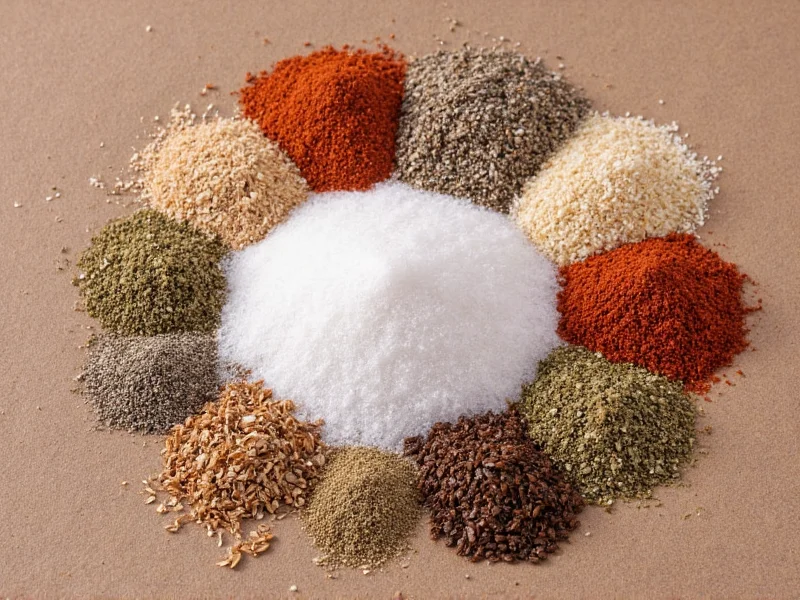Seasoning salt is a versatile kitchen staple that transforms ordinary dishes into flavorful creations. Understanding exactly what is in seasoning salt helps home cooks make informed choices about their ingredients and create better meals. This comprehensive guide explores the composition, variations, and practical uses of this popular seasoning blend.
Core Components of Seasoning Salt
While formulations vary by brand and regional preferences, most seasoning salts share a common foundation of ingredients. The base is always salt, which typically makes up 80-85% of the mixture. This high salt content serves as both a flavor enhancer and preservative.
The remaining portion consists of dried herbs and spices that create the distinctive flavor profile. The most common additional ingredients include:
| Ingredient | Typical Percentage | Flavor Contribution |
|---|---|---|
| Salt | 80-85% | Base seasoning, enhances other flavors |
| Garlic powder | 5-7% | Savory, aromatic depth |
| Onion powder | 3-5% | Sweet, pungent background note |
| Paprika | 2-4% | Earthy, slightly sweet with color |
| Black pepper | 1-2% | Subtle heat and complexity |
Brand Variations in Seasoning Salt Composition
Commercial seasoning salts differ in their specific formulations, creating distinct flavor profiles that cater to various culinary traditions. Understanding these differences helps you select the right product for your cooking needs.
Lawry's seasoned salt, one of the most popular commercial varieties in the United States, contains salt, garlic, paprika, onion, sugar, cornstarch, spices, magnesium carbonate, and silicon dioxide. The inclusion of sugar gives it a slightly sweet undertone that works well with grilled meats.
Morton Tenderizer, another common product, includes salt, sugar, papain (a meat tenderizing enzyme), spices, and silicon dioxide. This formulation serves a dual purpose as both a flavor enhancer and meat tenderizer.
International variations exist too. In the Caribbean, seasoning salts often include allspice and thyme. Middle Eastern versions might feature cumin and coriander. These regional adaptations demonstrate how seasoning salt evolves to match local taste preferences.
Nutritional Considerations of Seasoning Salt
When examining what spices are in seasoning salt, it's important to consider nutritional implications. A typical ¼ teaspoon serving contains about 190-200mg of sodium, which represents approximately 8-9% of the recommended daily intake.
The small amounts of additional spices provide trace nutrients. Garlic powder contributes allicin compounds with potential health benefits, while paprika offers carotenoids. However, the quantities are so small that seasoning salt shouldn't be considered a significant nutritional source.
For those monitoring sodium intake, low-sodium seasoning salt alternatives exist. These products replace some salt with potassium chloride and often increase the proportion of other spices to maintain flavor complexity without the high sodium content.
Practical Applications in Cooking
Understanding seasoning salt composition helps you use it effectively in various cooking applications. The balanced blend works particularly well as a:
- Dry rub for meats before grilling or roasting
- Finishing touch on roasted vegetables
- Base flavoring in soups and stews
- Enhancement for popcorn or snack foods
- Quick flavor boost for scrambled eggs or omelets
Chefs often recommend adding seasoning salt early in the cooking process for meats to allow flavors to penetrate, while using it as a finishing touch for vegetables to preserve the volatile compounds in the spices.
Creating Your Own Homemade Seasoning Salt
Knowing what is in seasoning salt empowers you to create custom blends tailored to your taste preferences. A basic homemade version requires just five ingredients:
- 1 cup fine sea salt
- 2 tablespoons garlic powder
- 2 tablespoons onion powder
- 1 tablespoon paprika
- 1 teaspoon freshly ground black pepper
Mix these ingredients thoroughly and store in an airtight container. The beauty of homemade seasoning salt is customization—you can adjust ratios to suit your preferences or add complementary spices like cumin for Mexican dishes or dried herbs like oregano for Mediterranean cuisine.
For specialty blends, consider these variations:
- Lemon-herb seasoning salt: Add 2 tablespoons dried parsley and 1 tablespoon lemon zest
- Smoky barbecue seasoning: Increase paprika to 2 tablespoons and add 1 teaspoon chipotle powder
- Italian seasoning salt: Add 1 tablespoon each dried basil, oregano, and thyme
Substitutions When You Run Out
If you're wondering what spices are in seasoning salt because you need a substitute, several options exist. The simplest replacement combines equal parts salt and garlic powder with smaller amounts of onion powder and paprika.
For specific dishes, consider these alternatives:
- For meats: Use a 3:1 ratio of salt to garlic powder with a pinch of black pepper
- For vegetables: Try herb salt (salt blended with dried herbs)
- For soups: Use a combination of salt and onion powder with a dash of celery salt
Remember that plain salt lacks the complexity of seasoning salt, so you'll need to supplement with additional spices to achieve similar flavor depth.
Storage and Shelf Life Considerations
Proper storage maintains the quality of both commercial and homemade seasoning salt. Keep your blend in an airtight container away from heat, light, and moisture. When stored properly, seasoning salt retains optimal flavor for 6-12 months.
Over time, the volatile compounds in the spices degrade, resulting in diminished flavor. While not harmful, old seasoning salt loses its potency. A simple test: rub a small amount between your fingers and smell it. If the aroma is weak, it's time to replace your blend.











 浙公网安备
33010002000092号
浙公网安备
33010002000092号 浙B2-20120091-4
浙B2-20120091-4